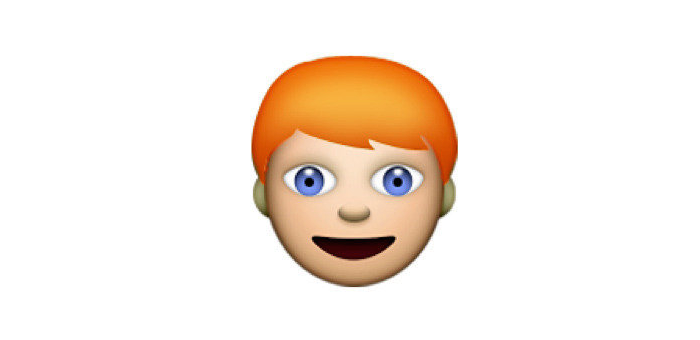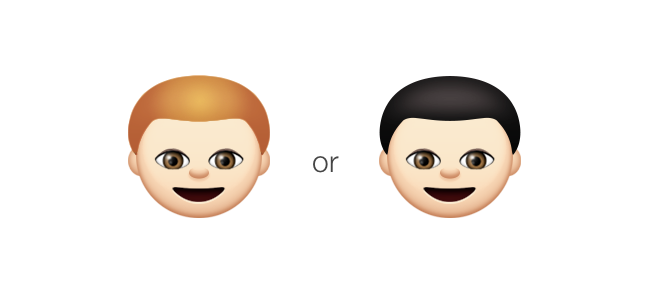The Trouble With Redheads
The results are in: diverse emoji support is either inclusive, divisive, overdue, or not even necessary.
Separate from the debate on the necessity of skin tone modifiers, is the question of a redhead[1] emoji.

Above: An Emoji With Red Hair. Image: Ginger Parrot
Hair, There, Everywhere
Unicode makes note the following regarding emoji hair color, and how it should be implemented in a diverse emoji world:
Dark hair is recommended for generic images that include hair. People of every skin tone can have black (or very dark brown) hair, so it is more neutral. One exception is Person With Blond Hair, which needs to have blond hair regardless of skin tone.
This is exactly how Apple approached the default emoji faces in the developer builds of iOS 8.3. However the public release of iOS 8.3 curiously changed[2] the default hair color to yellow:

Outside the recommendation for default emoji hair color, the Unicode Consortium does not make specific mention of which hair colors should be used when a skin tone modifier is applied.
In fact, Unicode singles out discussion of "different hair styles and color, use of eyeglasses, various kinds of facial hair, different body shapes, different headwear, and so on" and states that:
It is beyond the scope of Unicode to provide an encoding-based mechanism for representing every aspect of human appearance diversity that emoji users might want to indicate.
Essentially, the choices regarding hair color for each skin tone is to be decided by each company when implementing their own emoji artwork.
What Apple Decided
Here is the current range of skin tone modifiers, and the hair colors that Apple assigns to each. Using the boy emoji as the example:

| Emoji | Modifier | Skin Tone | Hair Color |
|---|---|---|---|
| 👦🏻 | Fitzpatrick Type-1-2 | Pale | Black |
| 👦🏼 | Fitzpatrick Type-3 | Cream White | Blond |
| 👦🏽 | Fitzpatrick Type-4 | Brown | Brown |
| 👦🏾 | Fitzpatrick Type-5 | Dark Brown | Dark Brown |
| 👦🏿 | Fitzpatrick Type-5 | Black | Black |
The emoji modifier for the pale skin tone combines the two types on the Fitzpatrick Scale, into a single shade named Emoji Modifier Fitzpatrick Type-1-2.
Type 1 on the Fitzpatrick Scale is defined as:
Pale white; blond or red hair; blue eyes; freckles — Always burns, never tans
Type 2 on the Fitzpatrick Scale is defined as:
White; fair; blond or red hair; blue, green, or hazel eyes — Usually burns, tans minimally
Emphasis mine. So why does the pale boy have black hair in Apple's emoji font? The following hair colors would more closely match the descriptions above:

Above: Mockup with Type 1-2 on the Fitzpatrick Scale showing red hair
The Case Against Red Hair
Red hair is not very common. Very few people, as a percentage of the worldwide population, have red hair:
Red hair occurs naturally in 1–2% of the human population. It occurs more frequently (2–6%) in people of northern or western European ancestry, and less frequently in other populations.
Was this a factor in Apple's decision to omit a redhead from the emoji lineup? If the pale-skin (Type 1-2) emoji had red hair, what option would remain to represent those with white skin and dark hair? Namely those from large slice of Asia.

Finally, there are cross-platform implications. What Apple decides to do with emoji hair color does not mandate that Google or Microsoft do the same.
A Possible Solution
Individual skin tone modifiers for Fitzpatrick Type 1, and Fitzpatrick Type 2 could exist: one with red hair, one with black hair.

Above: Mockup of how six skin tone modifiers could look
There may be some pushback to this approach from vendors, as it would require potentially 100+ new emojis to be supported, given every human would gain this new option.
Should this be implemented, Unicode may also need to become more prescriptive in how skin tone modifiers should represent hair color.
One thing is clear: decisions like these are trickier than they may first appear, and while Unicode may set the standards, it still remains the platform-vendor's choice how to implement them.
It will be interesting to see how these questions are addressed when skin tone modifier support comes to Android and Windows in the coming months.
Related
I am using redhead to describe people with hair that is auburn, copper, orange or ginger. This is the correct terminology according to this article about red hair on Wikipedia which notes "The term redhead has been in use since at least 1510" ↩︎
This may have been due to the similarity between the default emoji appearance (yellow with black hair) and the pale-skin emoji appearance (white with black hair). Especially at small sizes, these were difficult to tell apart in the developer betas. ↩︎
